Chengxi Han
Open-CD: A Comprehensive Toolbox for Change Detection
Jul 22, 2024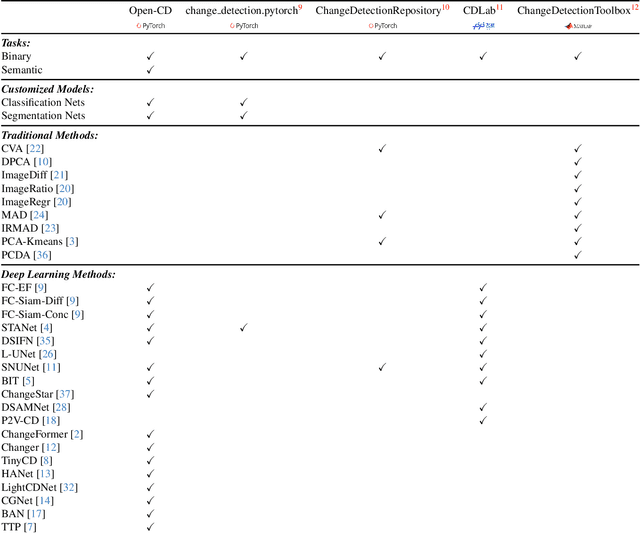
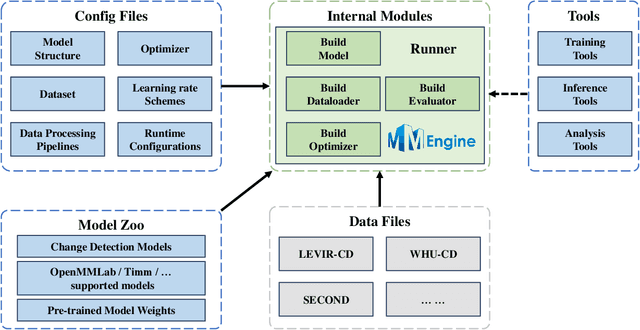

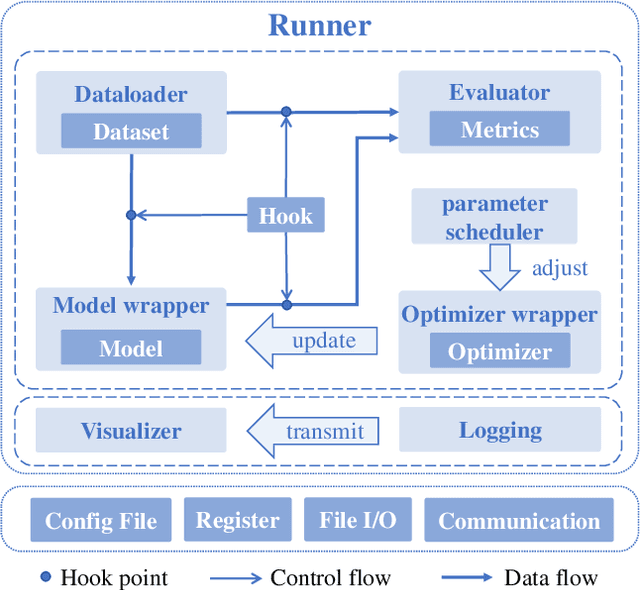
Abstract:We present Open-CD, a change detection toolbox that contains a rich set of change detection methods as well as related components and modules. The toolbox started from a series of open source general vision task tools, including OpenMMLab Toolkits, PyTorch Image Models, etc. It gradually evolves into a unified platform that covers many popular change detection methods and contemporary modules. It not only includes training and inference codes, but also provides some useful scripts for data analysis. We believe this toolbox is by far the most complete change detection toolbox. In this report, we introduce the various features, supported methods and applications of Open-CD. In addition, we also conduct a benchmarking study on different methods and components. We wish that the toolbox and benchmark could serve the growing research community by providing a flexible toolkit to reimplement existing methods and develop their own new change detectors. Code and models are available at \url{https://github.com/likyoo/open-cd}. Pioneeringly, this report also includes brief descriptions of the algorithms supported in Open-CD, mainly contributed by their authors. We sincerely encourage researchers in this field to participate in this project and work together to create a more open community. This toolkit and report will be kept updated.
HyperSIGMA: Hyperspectral Intelligence Comprehension Foundation Model
Jun 17, 2024



Abstract:Foundation models (FMs) are revolutionizing the analysis and understanding of remote sensing (RS) scenes, including aerial RGB, multispectral, and SAR images. However, hyperspectral images (HSIs), which are rich in spectral information, have not seen much application of FMs, with existing methods often restricted to specific tasks and lacking generality. To fill this gap, we introduce HyperSIGMA, a vision transformer-based foundation model for HSI interpretation, scalable to over a billion parameters. To tackle the spectral and spatial redundancy challenges in HSIs, we introduce a novel sparse sampling attention (SSA) mechanism, which effectively promotes the learning of diverse contextual features and serves as the basic block of HyperSIGMA. HyperSIGMA integrates spatial and spectral features using a specially designed spectral enhancement module. In addition, we construct a large-scale hyperspectral dataset, HyperGlobal-450K, for pre-training, which contains about 450K hyperspectral images, significantly surpassing existing datasets in scale. Extensive experiments on various high-level and low-level HSI tasks demonstrate HyperSIGMA's versatility and superior representational capability compared to current state-of-the-art methods. Moreover, HyperSIGMA shows significant advantages in scalability, robustness, cross-modal transferring capability, and real-world applicability.
C2F-SemiCD: A Coarse-to-Fine Semi-Supervised Change Detection Method Based on Consistency Regularization in High-Resolution Remote Sensing Images
Apr 22, 2024



Abstract:A high-precision feature extraction model is crucial for change detection (CD). In the past, many deep learning-based supervised CD methods learned to recognize change feature patterns from a large number of labelled bi-temporal images, whereas labelling bi-temporal remote sensing images is very expensive and often time-consuming; therefore, we propose a coarse-to-fine semi-supervised CD method based on consistency regularization (C2F-SemiCD), which includes a coarse-to-fine CD network with a multiscale attention mechanism (C2FNet) and a semi-supervised update method. Among them, the C2FNet network gradually completes the extraction of change features from coarse-grained to fine-grained through multiscale feature fusion, channel attention mechanism, spatial attention mechanism, global context module, feature refine module, initial aggregation module, and final aggregation module. The semi-supervised update method uses the mean teacher method. The parameters of the student model are updated to the parameters of the teacher Model by using the exponential moving average (EMA) method. Through extensive experiments on three datasets and meticulous ablation studies, including crossover experiments across datasets, we verify the significant effectiveness and efficiency of the proposed C2F-SemiCD method. The code will be open at: https://github.com/ChengxiHAN/C2F-SemiCDand-C2FNet.
HANet: A Hierarchical Attention Network for Change Detection With Bitemporal Very-High-Resolution Remote Sensing Images
Apr 14, 2024



Abstract:Benefiting from the developments in deep learning technology, deep-learning-based algorithms employing automatic feature extraction have achieved remarkable performance on the change detection (CD) task. However, the performance of existing deep-learning-based CD methods is hindered by the imbalance between changed and unchanged pixels. To tackle this problem, a progressive foreground-balanced sampling strategy on the basis of not adding change information is proposed in this article to help the model accurately learn the features of the changed pixels during the early training process and thereby improve detection performance.Furthermore, we design a discriminative Siamese network, hierarchical attention network (HANet), which can integrate multiscale features and refine detailed features. The main part of HANet is the HAN module, which is a lightweight and effective self-attention mechanism. Extensive experiments and ablation studies on two CDdatasets with extremely unbalanced labels validate the effectiveness and efficiency of the proposed method.
Change Guiding Network: Incorporating Change Prior to Guide Change Detection in Remote Sensing Imagery
Apr 14, 2024



Abstract:The rapid advancement of automated artificial intelligence algorithms and remote sensing instruments has benefited change detection (CD) tasks. However, there is still a lot of space to study for precise detection, especially the edge integrity and internal holes phenomenon of change features. In order to solve these problems, we design the Change Guiding Network (CGNet), to tackle the insufficient expression problem of change features in the conventional U-Net structure adopted in previous methods, which causes inaccurate edge detection and internal holes. Change maps from deep features with rich semantic information are generated and used as prior information to guide multi-scale feature fusion, which can improve the expression ability of change features. Meanwhile, we propose a self-attention module named Change Guide Module (CGM), which can effectively capture the long-distance dependency among pixels and effectively overcome the problem of the insufficient receptive field of traditional convolutional neural networks. On four major CD datasets, we verify the usefulness and efficiency of the CGNet, and a large number of experiments and ablation studies demonstrate the effectiveness of CGNet. We're going to open-source our code at https://github.com/ChengxiHAN/CGNet-CD.
ChangeMamba: Remote Sensing Change Detection with Spatio-Temporal State Space Model
Apr 14, 2024



Abstract:Convolutional neural networks (CNN) and Transformers have made impressive progress in the field of remote sensing change detection (CD). However, both architectures have inherent shortcomings. Recently, the Mamba architecture, based on state space models, has shown remarkable performance in a series of natural language processing tasks, which can effectively compensate for the shortcomings of the above two architectures. In this paper, we explore for the first time the potential of the Mamba architecture for remote sensing CD tasks. We tailor the corresponding frameworks, called MambaBCD, MambaSCD, and MambaBDA, for binary change detection (BCD), semantic change detection (SCD), and building damage assessment (BDA), respectively. All three frameworks adopt the cutting-edge Visual Mamba architecture as the encoder, which allows full learning of global spatial contextual information from the input images. For the change decoder, which is available in all three architectures, we propose three spatio-temporal relationship modeling mechanisms, which can be naturally combined with the Mamba architecture and fully utilize its attribute to achieve spatio-temporal interaction of multi-temporal features, thereby obtaining accurate change information. On five benchmark datasets, our proposed frameworks outperform current CNN- and Transformer-based approaches without using any complex training strategies or tricks, fully demonstrating the potential of the Mamba architecture in CD tasks. Specifically, we obtained 83.11%, 88.39% and 94.19% F1 scores on the three BCD datasets SYSU, LEVIR-CD+, and WHU-CD; on the SCD dataset SECOND, we obtained 24.11% SeK; and on the BDA dataset xBD, we obtained 81.41% overall F1 score. Further experiments show that our architecture is quite robust to degraded data. The source code will be available in https://github.com/ChenHongruixuan/MambaCD
MTP: Advancing Remote Sensing Foundation Model via Multi-Task Pretraining
Mar 20, 2024



Abstract:Foundation models have reshaped the landscape of Remote Sensing (RS) by enhancing various image interpretation tasks. Pretraining is an active research topic, encompassing supervised and self-supervised learning methods to initialize model weights effectively. However, transferring the pretrained models to downstream tasks may encounter task discrepancy due to their formulation of pretraining as image classification or object discrimination tasks. In this study, we explore the Multi-Task Pretraining (MTP) paradigm for RS foundation models to address this issue. Using a shared encoder and task-specific decoder architecture, we conduct multi-task supervised pretraining on the SAMRS dataset, encompassing semantic segmentation, instance segmentation, and rotated object detection. MTP supports both convolutional neural networks and vision transformer foundation models with over 300 million parameters. The pretrained models are finetuned on various RS downstream tasks, such as scene classification, horizontal and rotated object detection, semantic segmentation, and change detection. Extensive experiments across 14 datasets demonstrate the superiority of our models over existing ones of similar size and their competitive performance compared to larger state-of-the-art models, thus validating the effectiveness of MTP.
DeepCL: Deep Change Feature Learning on Remote Sensing Images in the Metric Space
Jul 23, 2023



Abstract:Change detection (CD) is an important yet challenging task in the Earth observation field for monitoring Earth surface dynamics. The advent of deep learning techniques has recently propelled automatic CD into a technological revolution. Nevertheless, deep learning-based CD methods are still plagued by two primary issues: 1) insufficient temporal relationship modeling and 2) pseudo-change misclassification. To address these issues, we complement the strong temporal modeling ability of metric learning with the prominent fitting ability of segmentation and propose a deep change feature learning (DeepCL) framework for robust and explainable CD. Firstly, we designed a hard sample-aware contrastive loss, which reweights the importance of hard and simple samples. This loss allows for explicit modeling of the temporal correlation between bi-temporal remote sensing images. Furthermore, the modeled temporal relations are utilized as knowledge prior to guide the segmentation process for detecting change regions. The DeepCL framework is thoroughly evaluated both theoretically and experimentally, demonstrating its superior feature discriminability, resilience against pseudo changes, and adaptability to a variety of CD algorithms. Extensive comparative experiments substantiate the quantitative and qualitative superiority of DeepCL over state-of-the-art CD approaches.
HCGMNET: A Hierarchical Change Guiding Map Network For Change Detection
Mar 13, 2023



Abstract:Very-high-resolution (VHR) remote sensing (RS) image change detection (CD) has been a challenging task for its very rich spatial information and sample imbalance problem. In this paper, we have proposed a hierarchical change guiding map network (HCGMNet) for change detection. The model uses hierarchical convolution operations to extract multiscale features, continuously merges multi-scale features layer by layer to improve the expression of global and local information, and guides the model to gradually refine edge features and comprehensive performance by a change guide module (CGM), which is a self-attention with changing guide map. Extensive experiments on two CD datasets show that the proposed HCGMNet architecture achieves better CD performance than existing state-of-the-art (SOTA) CD methods.
Transportation Density Reduction Caused by City Lockdowns Across the World during the COVID-19 Epidemic: From the View of High-resolution Remote Sensing Imagery
Mar 02, 2021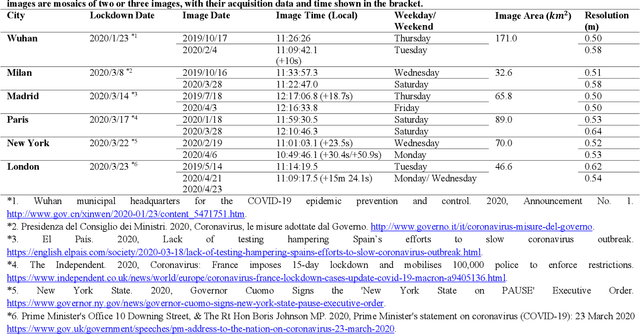

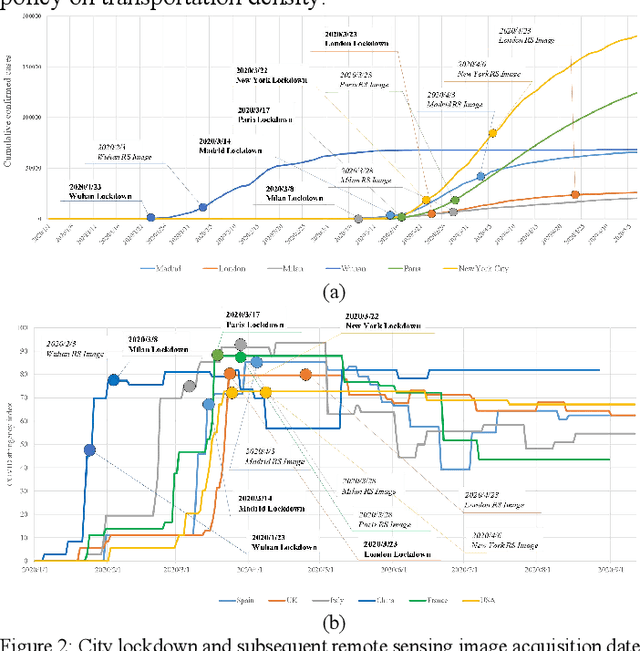
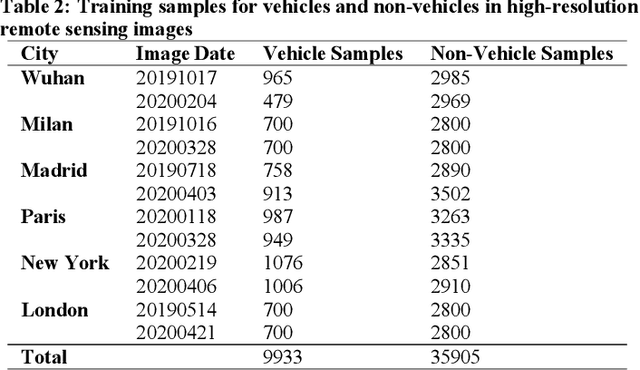
Abstract:As the COVID-19 epidemic began to worsen in the first months of 2020, stringent lockdown policies were implemented in numerous cities throughout the world to control human transmission and mitigate its spread. Although transportation density reduction inside the city was felt subjectively, there has thus far been no objective and quantitative study of its variation to reflect the intracity population flows and their corresponding relationship with lockdown policy stringency from the view of remote sensing images with the high resolution under 1m. Accordingly, we here provide a quantitative investigation of the transportation density reduction before and after lockdown was implemented in six epicenter cities (Wuhan, Milan, Madrid, Paris, New York, and London) around the world during the COVID-19 epidemic, which is accomplished by extracting vehicles from the multi-temporal high-resolution remote sensing images. A novel vehicle detection model combining unsupervised vehicle candidate extraction and deep learning identification was specifically proposed for the images with the resolution of 0.5m. Our results indicate that transportation densities were reduced by an average of approximately 50% (and as much as 75.96%) in these six cities following lockdown. The influences on transportation density reduction rates are also highly correlated with policy stringency, with an R^2 value exceeding 0.83. Even within a specific city, the transportation density changes differed and tended to be distributed in accordance with the city's land-use patterns. Considering that public transportation was mostly reduced or even forbidden, our results indicate that city lockdown policies are effective at limiting human transmission within cities.
 Add to Chrome
Add to Chrome Add to Firefox
Add to Firefox Add to Edge
Add to Edge